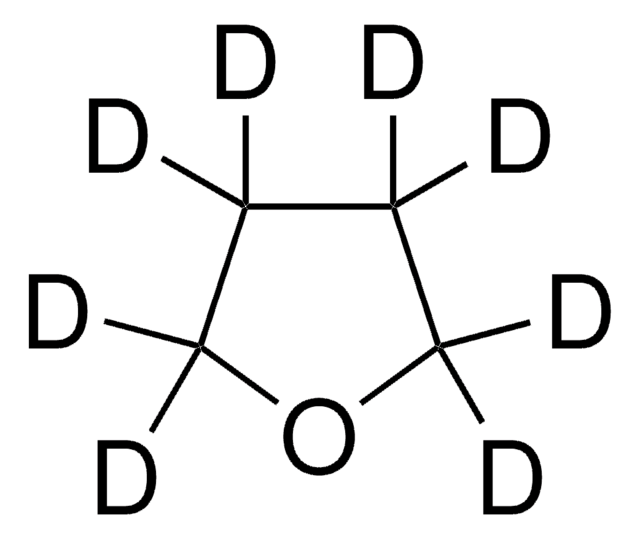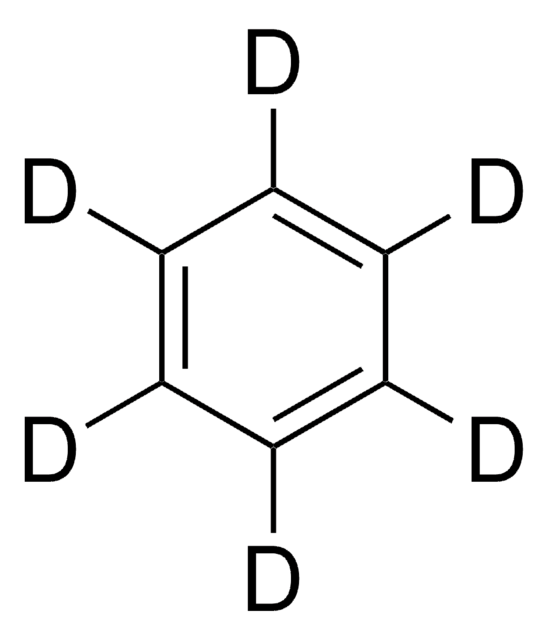269891
Tetrahidrofuran-d8
≥99.5 atom % D, contains 1 % (v/v) TMS
Sinónimos:
Octadeuterotetrahidrofurano, Tetrahidrofurano deuterado
About This Item
Productos recomendados
pureza isotópica
≥99.5 atom % D
Ensayo
≥99% (CP)
Formulario
liquid
contiene
1 % (v/v) TMS
técnicas
NMR: suitable
índice de refracción
n20/D 1.403 (lit.)
bp
65-66 °C (lit.)
mp
−106 °C (lit.)
densidad
0.985 g/mL at 25 °C (lit.)
cambio de masa
M+8
temp. de almacenamiento
2-8°C
cadena SMILES
[2H]C1([2H])OC([2H])([2H])C([2H])([2H])C1([2H])[2H]
InChI
1S/C4H8O/c1-2-4-5-3-1/h1-4H2/i1D2,2D2,3D2,4D2
Clave InChI
WYURNTSHIVDZCO-SVYQBANQSA-N
¿Está buscando productos similares? Visita Guía de comparación de productos
Aplicación
- Experimental and Theoretical Study of CO2 Insertion into Ruthenium Hydride Complexes.: This research provides insights into the mechanistic pathways for CO2 reactivity with ruthenium hydride complexes, potentially relevant for catalytic applications including transformations involving Tetrahydrofuran-d₈ (Ramakrishnan et al., 2016).
- Syntheses, structures, and NMR chemical shifts of a family of trimethyltin alkoxide, amide, halide and cyclopentadienyl compounds.: Details the synthesis and structural characterization of trimethyltin compounds, useful for understanding the coordination chemistry that may involve Tetrahydrofuran-d₈ as a solvent or structural analogue (Lichtscheidl et al., 2015).
- NMR studies of coupled low- and high-barrier hydrogen bonds in pyridoxal-5′-phosphate model systems in polar solution.: Discusses the application of NMR spectroscopy in studying hydrogen bonding interactions, where Tetrahydrofuran-d₈ could be utilized as a deuterated solvent for enhanced spectral clarity (Sharif et al., 2007).
- Stable hydrocarbon diradical, an analogue of trimethylenemethane.: Investigates stable hydrocarbon diradicals, where Tetrahydrofuran-d₈ may be used as part of the experimental setup to stabilize reactive intermediates or as a solvent to study radical stability (Rajca et al., 2005).
Productos recomendados
Palabra de señalización
Danger
Frases de peligro
Consejos de prudencia
Clasificaciones de peligro
Acute Tox. 4 Oral - Carc. 2 - Eye Irrit. 2 - Flam. Liq. 2 - STOT SE 3
Órganos de actuación
Central nervous system, Respiratory system
Riesgos supl.
Código de clase de almacenamiento
3 - Flammable liquids
Clase de riesgo para el agua (WGK)
WGK 1
Punto de inflamabilidad (°F)
1.4 °F - closed cup
Punto de inflamabilidad (°C)
-17 °C - closed cup
Elija entre una de las versiones más recientes:
¿Ya tiene este producto?
Encuentre la documentación para los productos que ha comprado recientemente en la Biblioteca de documentos.
Nuestro equipo de científicos tiene experiencia en todas las áreas de investigación: Ciencias de la vida, Ciencia de los materiales, Síntesis química, Cromatografía, Analítica y muchas otras.
Póngase en contacto con el Servicio técnico







